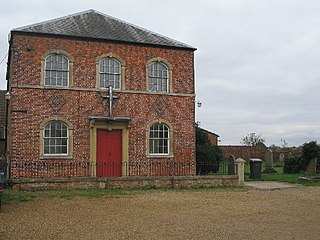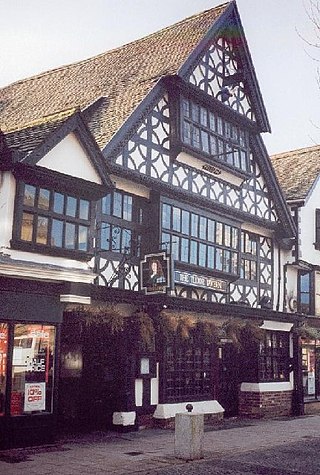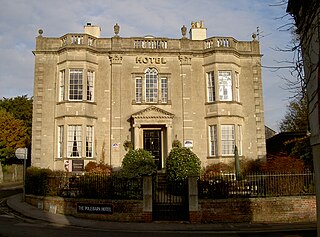
Trowbridge is the county town of Wiltshire, England; situated on the River Biss in the west of the county, close to the border with Somerset. The town lies 8 miles (13 km) south-east of Bath, 31 miles (50 km) south-west of Swindon and 20 miles (32 km) south-east of Bristol. The parish had a population of 37,169 in 2021.

Melksham is a town and civil parish on the River Avon in Wiltshire, England, about 4.5 miles (7 km) northeast of Trowbridge and 6 miles (10 km) south of Chippenham. At the 2021 census, the parish had a population of 18,113.

Westbury is a market town and civil parish in west Wiltshire, England. The town lies below the northwestern edge of Salisbury Plain, about 4 miles (6 km) south of Trowbridge and a similar distance north of Warminster.

Southwick is a semi-rural village and civil parish 3 miles (4.8 km) south-west of the county town of Trowbridge, Wiltshire, England. It is separated from the south-west fringe of Trowbridge only by the Southwick Country Park, which consists of 380 acres (150 ha) of open fields. The majority of the village lies south of the A361, which runs through the village, linking Trowbridge with Frome.
The year 1730 in architecture involved some significant events.
"Jack of Newbury" or John Winchcombe, also known as John Smallwood was a leading English clothier from Newbury in Berkshire. When Tudor cloth-making was booming, and woollen cloth dominated English exports, John Winchcombe was producing for export on an industrial scale.

Steeple Ashton is a village and civil parish in Wiltshire, England, 3 miles (4.8 km) east of Trowbridge.

Farleigh House, or Farleigh Castle, sometimes called Farleigh New Castle, is a large English country house in the county of Somerset, formerly the centre of the Farleigh Hungerford estate. Much of the stone to build it came from the nearby Farleigh Hungerford Castle and the house is now a Grade II listed building.

Sir Joseph Ashe, 1st Baronet was an English Whig politician and merchant.

Bulkington is a village and civil parish in the county of Wiltshire, England. The village is about 4.5 miles (7.2 km) west of Devizes and a similar distance southeast of Melksham.

The Tudor Tavern at No 15 Fore Street, Taunton, Somerset, England has been designated as a Grade I listed building. Built in 1578, the house is three storeys high of a timber-frame construction, with jettied first and second floors. The frontage is of carved bressummers with interlocking curved braces, while the roof is red tiles. There is a medieval hall with an open trussed roof behind the front.
Abraham Laverton, of Westbury, Wiltshire, was an English cloth mill owner, Liberal Member of Parliament for the parliamentary borough of Westbury from 1874 to 1880, and philanthropist.

Ushers of Trowbridge was a brewery in Trowbridge, Wiltshire, England, between 1824 and 2000.

Blackwell Hall in the City of London was the centre for the wool and cloth trade in England from mediaeval times until the 19th century. Cloth manufacturers and clothiers from provincial England brought their material to Blackwell Hall to display and sell it to merchants and drapers.
William Stumpe of Malmesbury, Wiltshire, was a clothier, Sheriff of Wiltshire, and briefly a member of parliament.

The Polebarn Hotel in Trowbridge, Wiltshire is a building of historical significance and is Grade II* listed on the Historic England Register. It was built in 1789 by John Clark, a local textile mill owner and clergyman. It passed through successive generations of the Clark family until it was sold by auction in about 1920 to Wiltshire County Council, who used it firstly for Children's Services and later as flats. The house became a hotel in 1978.

Southwick Court is a Grade II* listed moated medieval manor house at the centre of a system of fields and water meadows that lie between the town of Trowbridge and the village of Southwick in Wiltshire, England. It has remained a private residence under a succession of owners for at least 800 years. The current house dates from the late 16th century, but its gatehouse is late 15th century. Both were built on the site of an older manor house, dating back to the 13th century or before. Nothing remains of the original house, though the current building sits within the same footprint.

Trowbridge Town Hall is a municipal building in Market Street, Trowbridge, Wiltshire, England. The town hall, which was the headquarters of Trowbridge Urban District Council, is a Grade II listed building.
Sir William Roger Brown, known as Roger Brown, was an English mill-owner and philanthropist, lord of the manor of Beckington in Somerset.
Paul Methuen (1613–1667) was a wealthy English clothier of Bradford-on-Avon, Wiltshire, described by antiquary John Aubrey as 'the greatest clothier of his time'.














